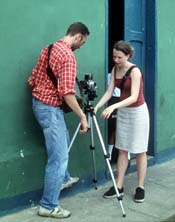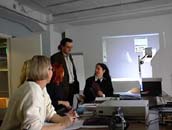Displaying Culture was a joint project of the Department of Anthropology, University of Helsinki, the Helinä Rautavaara Museum, the Media Lab, University of Art and Design and the Finnish Anthropological Society.
The project was initiated by Eija-Maija Kotilainen, the director of the Helinä Rautavaara Museum, in autumn 1998 when she contacted Ilkka Ruohonen at the Department of Anthropology, University of Helsinki. They agreed to start a project in order to organize a field trip to Venezuela, collect visual and sound material there and create an exhibition using that material. Ilkka Ruohonen and other members of the department had already experience doing fieldwork in Venezuela and from the very beginning the project was included in the teaching programme of the department.
In the autumn 1998 Ilkka Ruohonen and Eija-Maija Kotilainen arranged a seminar for the students of anthropology. The purpose of the seminar was to come to know the history, economics, politics and ethnography of Venezuela, but also to study how to display other cultures. The planning of the fieldwork and exhibition were started, too. The group was soon completed by Pekka Koponen, expert in new media and information technology, and Patrik Rastenberger, photographer, both having earlier experience of working in Venezuela. The team succeeded to get financing for their fieldtrip from the University of Helsinki, Finnish Cultural Foundation and Apple Co.
| The fieldwork was supervised by Pekka Koponen, Eija-Maija Kotilainen, Patrik Rastenberger, Ilkka Ruohonen and the work itself was carried out by seven students of anthropology in a small Caribbian town Carúpano during the Easter 1999. The town Carúpano was selected because several members of the group already knew the town which made the entry into the field much easier. The purpose of the fieldwork was to teach students to collect anthropological material using audiovisual equipments and at the same time to do documentation for a museum exhibition. The material was gathered using digital still and video cameras and sound.
Because of the limited time it was decided to concentrate on collecting audiovisual material in public places: churches, market places, shops, streets etc. Luckily access to private homes was also found. Easter time was chosen because in a Catholic country like Venezuela it certainly would be special festival time with public religious rituals. What the team did not know was that in Venezuela Easter (Semana Santa) is also an important holiday season when young people and families go to beach. Actually, this contrast between religious celebration of Easter and having fun by drinking and dancing in the beach became the central theme of the documentation. |
 |
From the beginning one of the aims of the Semana Santa exhibition has been to display everyday life of ordinary people, in this case, living in Venezuela. We have wanted to avoid exoticing foreign culture so often done in ethnographical museums and exhibitions. We have been very aware, that while transferring Venezuelan culture to a museum display, we actually are creating our own reality, our experience of Venezuela not the real thing. An exhibition is never real, it is always created by group of people.
| In the autumn of 1999 a new phase in the project started with Lily Diaz and Maria Koskijoki from the Media Lab, University of Art and Design. The project Displaying culture comprised of a series of activities designed to foster interaction between MA students from two different areas of inquiry, namely anthropology and new media design. For example, a lecture series given by experts in topics such as: Museums and the Construction of Identity, Creating an Anthropological Exhibition, Who is the Other? sought to highlight the ideological frameworks that have colored anthropological and museal exhibitions in general. |
 |
The final objective for this phase of the project was to create a presentation that would include the design and production specifications for the present exhibition, Semana Santa in Carúpano, Venezuela. This presentation was co-designed by the anthropology and design students. It was presented on December 13, 1999, to an audience that included members from the faculty of the department of Anthropology, the Media Lab, and the Board of Directors of the Helin Rautavaara. The documentation and many of the materials utilized in this event are available in the web site for the project: http://www.mlab.uiah.fi/displayculture
.